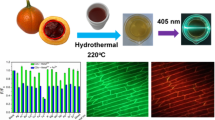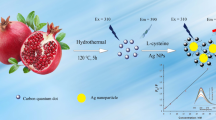Abstract
The carbon quantum dots (CQDs) have been prepared from medlar seeds with pyrolysis method in an oven at 300 °C. UV-vis absorption spectroscopy, fluorescence spectroscopy, Fourier transform infrared spectroscopy (FTIR) spectroscopy, x-ray diffraction (XRD) technique, x-ray photoelectron spectroscopy (XPS), and transmission electron microscopy (TEM) were used in the characterization of CQDs. CQDs, give a strong blue fluorescence under UV lamp (at 365 nm), have a quantum yield of 12.2%. The influence of metal ions such as K+, Mg2+, Ca2+, Be2+, Cr3+, Mn2+, Ni2+, Ag+, Hg2+, and Al3+ on the fluorescence properties of the CQDs was investigated by means of emission spectrophotometry. CQDs altering fluorescence characteristics depending on the excitation wavelength show selectivity for Hg2+ ions with outstanding fluorescence quenching among the tested metal ions. Based on these results, a new fluorimetric method has been developed for the determination of Hg2+ in real water samples. The linear range of method is 1.0 to 5.0 mgL− 1. Limit of detection and limit of quantification are 0.26 and 0.79 mgL− 1, respectively. The proposed method has been successfully used in determination of Hg2+ ions in tap, sea, and stream water samples with application of addition-recovery experiments.








Similar content being viewed by others
Data Availability
Datasets and materials used can be reached from Nurhayat Özbek.
References
Bui MPN, Brockgreitens J, Ahmed S, Abbas A (2016) Dual detection of nitrate and mercury in water using disposable electrochemical sensors. Biosens Bioelectron 85:280–286. https://doi.org/10.1016/j.bios.2016.05.017
Schrope M (2001) US to take temperature of mercury threat. Nature 409:124. https://doi.org/10.1038/35051770
Makam P, Shilpa R, Kandjani AE, Periasamy SR, Sabri YM, Madhu C, Bhargava SK, Govindaraju T (2018) SERS and fluorescence-based ultrasensitive detection of mercury in water. Biosens Bioelectron 100:556–564. https://doi.org/10.1016/j.bios.2017.09.051
Kallithrakas-Kontos N, Foteinis S (2016) Recent advances in the analysis of mercury in water – review. Curr Anal Chem 12:22–36. https://doi.org/10.2174/157341101201151007120324
EPA (2023) https://www.epa.gov/ground-water-and-drinking-water/national-primary-drinking-water-regulations. Last updated on January 9, 2023
WHO (2022) Guidelines for drinking-water quality: fourth edition incorporating the first and second addenda. World Health Organization, Geneva. https://www.who.int/publications/i/item/9789240045064 Licence: CC BY-NC-SA 3.0 IGO
Das R, Bandyopadhyay R, Pramanik P (2018) Carbon quantum dots from natural resource: a review. Mater Today Chem 8:96–109. https://doi.org/10.1016/j.mtchem.2018.03.003
Zuo P, Lu X, Sun Z, Guo Y, He H (2016) A review on syntheses, properties, characterization and bioanalytical applications of fluorescent carbon dots. Microchim Acta 183:519–542. https://doi.org/10.1007/s00604-015-1705-3
Speranza G (2021) Carbon nanomaterials: synthesis, functionalization and sensing applications. Nanomaterials 11:967. https://doi.org/10.3390/nano11040967
Shah AQ, Kazi TG, Baig JA, Afridi HI, Arain MB (2012) Simultaneously determination of methyl and inorganic mercury in fish species by cold vapour generation atomic absorption spectrometry. Food Chem 134:2345–2349. https://doi.org/10.1016/j.foodchem.2012.03.109
Wen G, Wen X, Choi MMF, Shuang S (2015) Photoelectrochemical sensor for detecting Hg2+ based on exciton trap**. Sens Actuators B Chem 221:1449–1454. https://doi.org/10.1016/j.snb.2015.07.103
Zhang JR, Huang WT, Zeng AL, Luo HQ, Li NB (2015) Ethynyl and π-stacked thymine–Hg2+–thymine base pairs enhanced fluorescence quenching via photoinduced electron transfer and simple and sensitive mercury ion sensing. Biosens Bioelectron 64:597–604. https://doi.org/10.1016/j.bios.2014.09.092
Jamshidi M, Ghaedi M, Mortazavi K, Biareh MN, Soylak M (2011) Determination of some metal ions by flame-AAS after their preconcentration using sodium dodecyl sulfate coated alumina modified with 2-hydroxy-(3-((1-H-indol 3-yle) phenyl) methyl) 1-H-indol (2-HIYPMI). Food Chem Toxicol 49:1229–1234. https://doi.org/10.1016/j.fct.2011.02.025
Wang BS, Lee CP, Ho TY (2014) Trace metal determination in natural waters by automated solid phase extraction system and ICP-MS: the influence of low level mg and ca. Talanta 128:337–344. https://doi.org/10.1016/j.talanta.2014.04.077
Kappen J, Aravind MK, Varalakshmi P et al (2020) Hydroxyl rich graphene quantum dots for the determination of hg (II) in the presence of large concentration of major interferents and in living cells. Microchem J 157:104915. https://doi.org/10.1016/j.microc.2020.104915
Fu WJ, Peng ZX, Dai Y, Yang YF, Song JY, Sun W, Ding B, Gu HW, Yin XL (2022) Highly fluorescent N doped C-dots as sensor for selective detection of Hg2+ in beverages. Spectrochim Acta-A:Mol Biomol Spectrosc 265:120392. https://doi.org/10.1016/j.saa.2021.120392
Liu Z, ** W, Wang F, Li T, Nie J, **ao W, Zhang Q, Zhang Y (2019) Ratiometric fluorescent sensing of Pb2+ and Hg2+ with two types of carbon dot nanohybrids synthesized from the same biomass. Sens Actuator B Chem 296:126698. https://doi.org/10.1016/j.snb.2019.126698
Solgi M, Najib T, Ahmadnejad S, Nasernejad B (2017) Synthesis and characterization of novel activated carbon from medlar seed for chromium removal: experimental analysis and modeling with artificial neural network and support vector regression. Resource-Efficient Technol 3:236–248. https://doi.org/10.1016/j.reffit.2017.08.003
Gruz J, Ayaz FA, Torun H, Strnad M (2011) Phenolic acid content and radical scavenging activity of extracts from medlar (Mespilus germanica L) fruit at different stages of ripening. Food Chem 124(1):271–277. https://doi.org/10.1016/j.foodchem.2010.06.030
Cevahir G, Bostan SZ (2021) Organic acids, sugars and bioactive compounds of promising medlar (Mespilus Germanica L.) genotypes selected from Turkey. Int J Fruit Sci 21(1):312–322. https://doi.org/10.1080/15538362.2021.1874594
Periyasamy S, Kumar IA, Viswanathan N (2020) Activated Carbon from different Waste materials for the removal of toxic Metals. In: Naushad M, Lichtfouse E (eds) Green materials for Wastewater Treatment. Environmental Chemistry for a sustainable world, vol 38. Springer, Cham. https://doi.org/10.1007/978-3-030-17724-9
Topak F, Akalin MK (2023) Production of bio-oil via catalytic pyrolysis of medlar seeds. BioResources 18(2):3144–3159. https://doi.org/10.15376/biores.18.2.3144-3159
Taniguchi M, Lindsey JS (2018) Database of absorption and fluorescence spectra of > 300 common compounds for use in photochem CAD. Photochem Photobiol 94:290–327. https://doi.org/10.1111/php.12860
Siddique AB, Pramanick AK, Chatterjee S, Ray M (2018) Amorphous carbon dots and their remarkable ability to detect 2,4,6-trinitrophenol. Sci Rep 8(1):1–10. https://doi.org/10.1038/s41598-018-28021-9
Kelarakis A (2014) From highly graphitic to amorphous carbon dots: a critical review. MRS Energy Sustainability. https://doi.org/10.1557/mre.2014.7. 1: E2
Bhaisare ML, Talib A, Khan MS, Pandey S, Wu HF (2015) Synthesis of fluorescent carbon dots via microwave carbonization of citric acid in presence of tetraoctylammonium ion, and their application to cellular bioimaging. Microchim Acta 182:2173–2181. https://doi.org/10.1007/s00604-015-1541-5
Essner JB, Laber CH, Ravula S, Polo-Parada L, Baker GA (2016) Pee-dots: biocompatible fluorescent carbon dots derived from the upcycling of urine. Green Chem 18(1):243–250. https://doi.org/10.1039/c5gc02032h
Hinrichs R, Zen Vasconcellos MA, Österle W, Prietzel C (2018) Amorphization of graphite flakes in gray cast iron under tribological load. Mat Res 21(4):e20171000. https://doi.org/10.1590/1980-5373-MR-2017-1000
Gümrükçüoğlu A, Başoğlu A, Kolaylı S, Dinç S, Kara M, Ocak M, Ocak Ü (2020) Highly sensitive fluorometric method based on nitrogen-doped carbon dot clusters for tartrazine determination in cookies samples. Turk J Chem 44:99–111. https://doi.org/10.3906/kim-1903-28
Wang L, Bi Y, Hou J, Li H, Xu Y, Wang B, Ding H, Ding L (2016) Facile, green and clean one-step synthesis of carbon dots from wool: application as a sensor for glyphosate detection based on the inner filter effect. Talanta 160:268–275. https://doi.org/10.1016/j.talanta.2016.07.020
Gao X, Lu Y, Zhang R, He S, Ju J, Liu M, Li L, Chen W (2015) One-pot synthesis of carbon nanodots for fluorescence turn-on detection of Ag+ based on the Ag+-induced enhancement of fluorescence. J Mater Chem C 3:2302–2309. https://doi.org/10.1039/C4TC02582B
Teng X, Ma C, Ge C, Yan M, Yang J, Zhang Y et al (2014) Green synthesis of nitrogen-doped carbon dots from konjac flour with off–on fluorescence by Fe3+ and l-lysine for bioimaging. J Mater Chem B 2:4631. https://doi.org/10.1039/C4TB00368C
Abd Elhaleem SM, Elsebaei F, Shalan S, Belal F (2022) Utilization of N,S-doped carbon dots as a fluorescent nanosensor for determination of cromolyn based on inner filter effect: application to aqueous humour. Luminescence 37:713–721. https://doi.org/10.1002/bio.4212
Shabbir H, Csapó E, Wojnicki M (2023) Carbon quantum dots: the role of surface functional groups and proposed mechanisms for metal ion sensing. Inorganics 11(6):262. https://doi.org/10.3390/inorganics11060262
Chen RF (1990) Fluorescence of proteins and peptides. In: Guilbault GG (ed) Practical fluorescence, 2nd edn. Dekker, New York, p 595
Cha KW, Park KW (1998) Determination of iron(III) with salicylic acid by the fluorescence quenching method. Talanta 46:1567–1571. https://doi.org/10.1016/S0039-9140(98)00032-0
Li T, Ning Y, Pang J, Chen L, Zhang F, Chai F (2023) Green and facile synthesis of silicon-doped carbon dots and their use in detection of Hg2+ and visualization of latent fingerprints. New J Chem 47:147–155. https://doi.org/10.1039/D2NJ04671G
Liu H, Li H, Du K, Xu H (2022) Yellow fluorescent carbon dots sensitive detection of Hg2+ and its detection mechanism. Mater Today Commun 33:104880. https://doi.org/10.1016/j.mtcomm.2022.104880
Samota S, Tewatia P, Rani R, Chakraverty S, Kaushik A (2022) Carbon dot nanosensors for ultra-low level, rapid assay of mercury ions synthesized from an aquatic weed, Typha angustata Bory (Patera). Diam Relat Mater 130:109433. https://doi.org/10.1016/j.diamond.2022.109433
Pajewska-Szmyt M, Buszewski B, Gadzała-Kopciuch R (2020) Sulphur and nitrogen doped carbon dots synthesis by microwave assisted method as quantitative analytical nano-tool for mercury ion sensing. Mater Chem Phys 242:122484. https://doi.org/10.1016/j.matchemphys.2019.122484
Funding
No funding.
Author information
Authors and Affiliations
Contributions
Nurhayat Özbek, Miraç Ocak, and Ümmühan Turgut Ocak wrote the main manuscript text and Ender Çekirge prepared all figures. All authors reviewed the manuscript.
Corresponding author
Ethics declarations
Competing Interests
The authors declare no competing interests.
Ethical Approval
An ethics approval is not legally required for the study.
Additional information
Publisher’s Note
Springer Nature remains neutral with regard to jurisdictional claims in published maps and institutional affiliations.
Rights and permissions
Springer Nature or its licensor (e.g. a society or other partner) holds exclusive rights to this article under a publishing agreement with the author(s) or other rightsholder(s); author self-archiving of the accepted manuscript version of this article is solely governed by the terms of such publishing agreement and applicable law.
About this article
Cite this article
Özbek, N., Çekirge, E., Ocak, M. et al. Highly Blue-fluorescent Carbon Quantum Dots Obtained from Medlar Seed for Hg2+ Determination in Real Water Samples. J Fluoresc (2023). https://doi.org/10.1007/s10895-023-03463-1
Received:
Accepted:
Published:
DOI: https://doi.org/10.1007/s10895-023-03463-1




